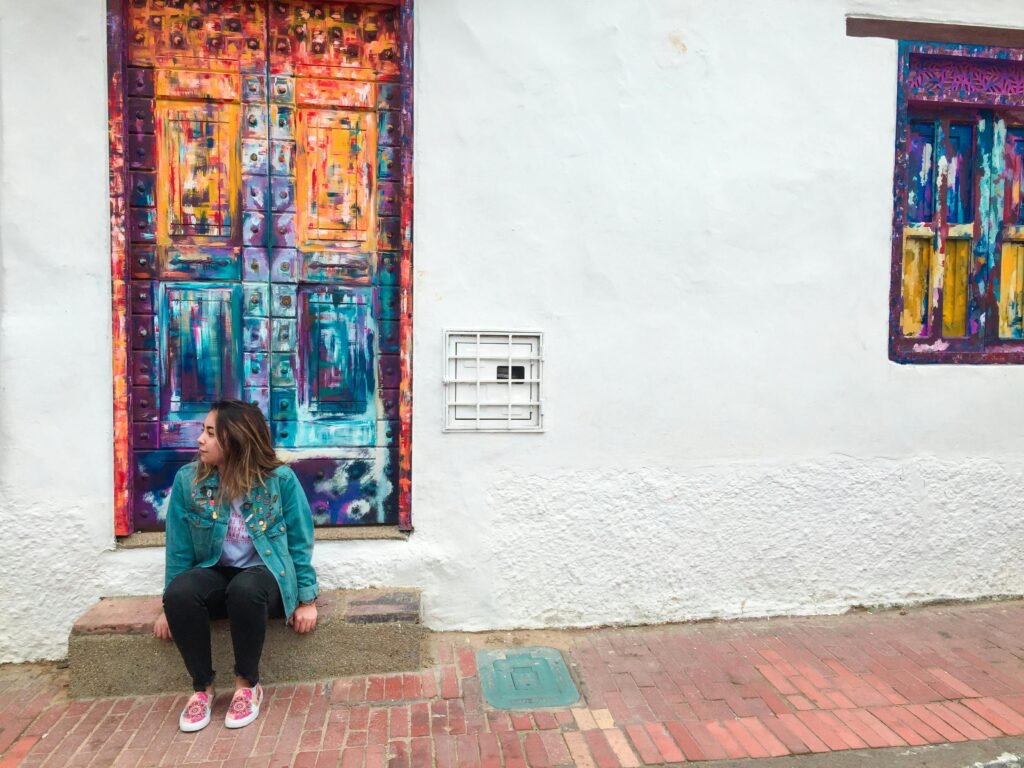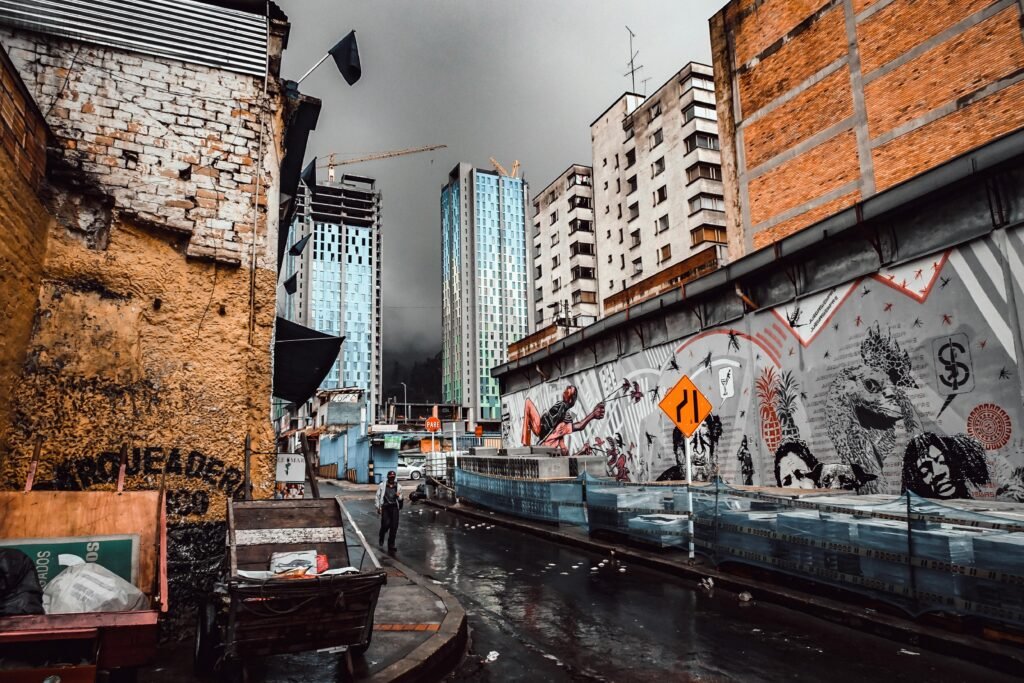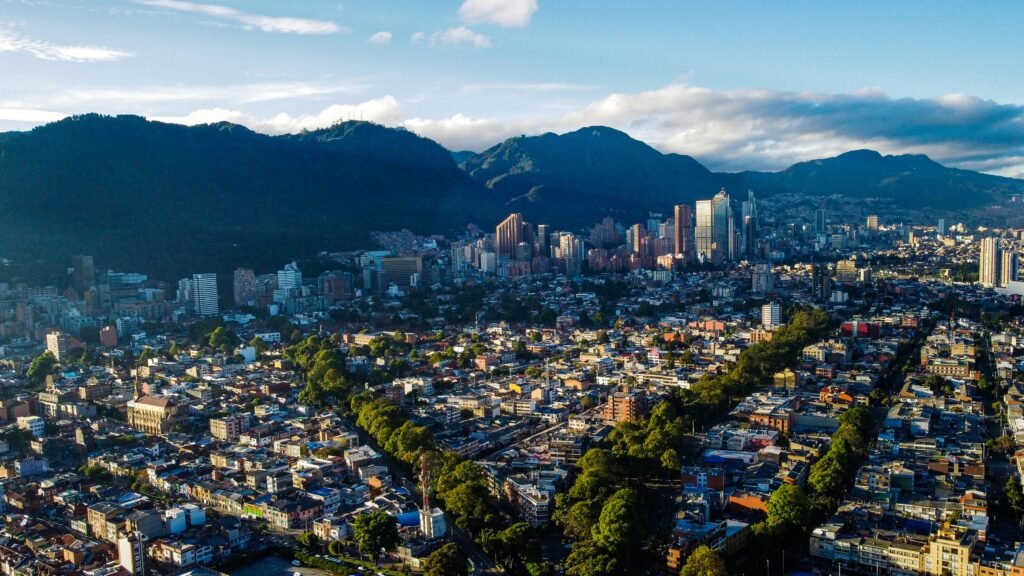Introduction to Colombia’s Artistic Landscape
Colombia possesses a vibrant artistic landscape that reflects the country’s diverse heritage and cultural identity. The nation’s art is not only a form of expression but also a medium that encapsulates its historical narratives and social dynamics. From the pre-Columbian era to contemporary practices, Colombian art has evolved through the influences of indigenous communities, colonial experiences, and modern global trends, resulting in a unique and captivating tapestry of creativity.

Art in Colombia serves as a mirror to the society, often addressing themes such as identity, conflict, and resilience. The significance of art can be observed in various forms, including visual arts, music, dance, and theatrical performances. For instance, Bogotá, the capital city, is adorned with renowned murals that transform urban spaces into open-air galleries, illustrating the profound stories of its people and environment. Such creativity acts as a mechanism for community engagement and dialogue, fostering a sense of belonging and unity among citizens.
Additionally, events like the Barranquilla Carnival showcase Colombia’s rich cultural traditions through vibrant parades, music, and dance. This festival, one of the most significant in Colombia, highlights the importance of artistic expression as a form of cultural heritage, blending indigenous, African, and European elements. The carnival not only celebrates artistic creativity but also strengthens community ties and highlights the collective spirit of the Colombian people.
As Colombia continues to evolve, the emphasis on artistic expression remains essential in shaping its national identity. The dynamic interplay of different art forms allows for continual exploration and reinterpretation of culture, making it an enduring aspect of Colombia’s heritage. Through further examination of various artistic mediums, one can appreciate the profundity of their contributions to the nation’s identity and society overall.
The Vibrant Murals of Bogotá
Bogotá, Colombia’s capital, stands out as a creative hub teeming with vibrant murals and expressive urban artwork. The city’s murals, particularly concentrated in the historic neighborhood of La Candelaria, provide a captivating narrative of the social, political, and cultural dynamics that characterize Colombian society. This urban art scene reflects a diverse range of themes; from the struggles associated with historical injustices to the celebration of cultural resilience, each mural is a testament to the collective voice of its community.
Artists such as Juan Carlos Pinzón and the collective known as “Graffiti Colombia” have gained recognition for their significant contributions to Bogotá’s street art. Their works convey important societal messages while intertwining regional history and cultural pride, showcasing both individual talent and collective creativity. This artistic movement has not only beautified the urban landscape but also initiated critical conversations around national identity, social inequality, and political issues affecting the populace.

Moreover, community initiatives play a key role in promoting street art as a vehicle for self-expression. Programs like “Urban Art in Action” engage local youth in mural painting workshops, empowering them to tell their stories and express their identity through art. These projects not only foster artistic skills but also help reduce violence and encourage peaceful coexistence among diverse social groups. The murals of Bogotá thus symbolize more than mere aesthetics; they embody hope, resistance, and empowerment.
As Bogotá continues to evolve, its urban art scene signals a commitment to creativity and community engagement. The ongoing projects and collaborations between artists and local governments aim to elevate this vibrant cultural expression, ensuring that the stories told through murals resonate with both residents and visitors alike. With each brushstroke, Bogotá’s artists contribute to a dynamic dialogue about the nation’s past and future, making the city a living canvas of art and life.
Art Movements and Influences in Colombia
Colombia is a nation rich in artistic expression, shaped by various movements that reflect its complex history and social landscape. The evolution of art in Colombia is largely influenced by historical events, including periods of colonialism, conflict, and significant social changes. The modernist movement in the early 20th century brought with it a wave of experimentation and a departure from traditional artistic expressions, as artists began to pursue new aesthetics and ideas. Prominent figures such as the painter and muralist Débora Arango emerged during this period, merging modernist styles with local themes that reflected the Colombian identity.
As Colombia navigated its tumultuous 20th-century history, characterized by civil strife and social upheaval, the contemporary art movement began to take shape. This period saw artists utilizing their work as a medium for commentary on social issues, thereby creating art that was both visually striking and socially relevant. Notable contemporary artists, including Doris Salcedo and Fernando Botero, have often addressed themes of violence and injustice, drawing attention to the realities faced by the Colombian populace. Their contributions have not only elevated Colombian art on a global scale but have also encouraged a dialogue about the impact of conflict on creative expression.
Furthermore, indigenous influences have significantly enriched the artistic landscape in Colombia. Traditional crafts and ancestral practices are interwoven with modern art forms, creating a unique fusion that honors indigenous heritage while simultaneously embracing contemporary techniques. This synthesis has allowed Colombian artists to develop styles that resonate with both national and international audiences, ultimately demonstrating how historical events and cultural diversity shape artistic movements across the country. Contemporary Colombian art continues to evolve, embodying the spirit of resilience and creativity inherent to its people.
Traditional Colombian Arts and Crafts
Colombia is renowned for its vibrant array of traditional arts and crafts, encompassing handicrafts, pottery, and textiles that reflect the rich cultural tapestry of the nation. These art forms are not only visually striking but also carry significant historical and cultural value, with many techniques handed down through generations. Indigenous communities play a pivotal role in preserving these traditional methods, ensuring that their ancestral heritage is honored and celebrated.
In the realm of handicrafts, Colombia offers a stunning variety of items, from intricately woven baskets to colorful ceramics. The artisans often utilize local materials, showcasing their connection to the land and environment. For instance, the use of fique, a natural fiber, is prominent in the crafting of artisanal products in the northern regions. Each piece tells a story, encapsulating the skills and traditions that have been preserved despite the passage of time.
Pottery work, particularly from regions such as Boyacá and the San Basilio de Palenque community, illustrates the creative spirit of Colombian artisans. These craftspeople often rely on techniques that date back hundreds of years, ensuring that their creations maintain authenticity while adapting to modern influences. The intricate designs and functional aspects of pottery not only serve aesthetic purposes but also promote social and regional cohesiveness among communities.
Textiles, another hallmark of Colombian traditional arts, boast vibrant colors and diverse patterns that vary by region. The weaving techniques employed by indigenous groups ensure that these textiles are more than just clothing; they embody cultural narratives and community identity. For many contemporary Colombians, engaging with these traditional crafts serves as a means to connect with their cultural roots, fostering social unity and pride in Colombia’s diverse heritage.
The Barranquilla Carnival: A Colorful Celebration of Culture
The Barranquilla Carnival is a renowned cultural event in Colombia, celebrated annually and recognized for its vivid display of artistry, music, and dance. Originating in the early 20th century, the carnival showcases the region’s rich traditions and cultural heritage, drawing spectators and participants from across the globe. It typically occurs during the four days preceding Ash Wednesday, marking the beginning of Lent, and serves as a time for vibrant expression and communal joy.

As one of the country’s most significant celebrations, the Barranquilla Carnival features an array of colorful costumes that reflect the diverse influences of Indigenous, African, and Spanish cultures. Participants don intricate outfits adorned with feathers, sequins, and beads, transforming the streets into a lively spectacle. The creativity displayed in these ensembles is not merely a visual feast but a celebration of cultural identity and artistic expression that embodies the spirit of Colombia.
Music and dance are integral components of the carnival, with lively rhythms of cumbia, mapalé, and porro permeating the air. Each genre contributes to the unique atmosphere, as locals and visitors join in various parades and dances that occur throughout the event. The carnival also serves as a stage for various performers, each offering their interpretation of Colombian folklore and contemporary themes, showcasing the evolution of art in this vibrant nation.
Ultimately, the Barranquilla Carnival stands as a testament to Colombia’s rich tapestry of culture. It is not just a festive occasion but an important platform for artistic expression, community pride, and the celebration of Colombia’s diverse artistic heritage. The carnival invites every participant to embrace and display their identity, making it a truly unique living canvas for Colombian culture.
The Role of Art in Social Change and Activism
In Colombia, art serves as a potent medium for social change, enabling artists to express their concerns about pressing issues such as inequality, violence, and environmental degradation. Numerous Colombian artists employ various techniques, from murals to performances, to bring attention to these critical matters, often using their work to inspire dialogue and mobilize communities toward positive action. This engagement illustrates the transformative potential of art in society, particularly in a country with a complex socio-political landscape.
One notable example of art’s role in activism is seen in Bogotá’s vibrant street art scene. Murals dot the city’s landscape, with many artworks addressing social injustices, historical memory, and the struggle against institutional violence. These large-scale public works not only beautify urban spaces but also serve as a canvas for social commentary, inviting passersby to reflect on their surroundings. In this context, artists become voices of the community, advocating for those who may feel marginalized or unheard.
Another significant event that emphasizes the intersection of art and activism in Colombia is the Barranquilla Carnival. While primarily a celebration of culture and heritage, this event also serves as a powerful platform for addressing social issues. Through the colorful parades and artistic expressions, participants often weave in messages of social justice and unity, creating a space where these discussions can unfold naturally amidst the festivities.
Furthermore, contemporary artists like Doris Salcedo utilize their work to confront themes of trauma and loss stemming from Colombia’s violent past. By harnessing their artistic talents, these creators shine a light on the realities faced by many Colombians, making art a bridge for healing and reconciliation. Through the integration of social critique in their work, these artists not only raise awareness but also encourage collective action, demonstrating that art can be a catalyst for significant social change.
Colombian Art and Global Recognition
Colombia has emerged as a significant player in the global art scene, with its artists gaining accolades and recognition that transcend national borders. The rich tapestry of Colombian art, deeply rooted in the country’s diverse culture, has seen renowned figures rise to prominence, showcasing their works in prestigious galleries and exhibitions worldwide. Artists such as Fernando Botero, known for his signature oversized figures, have captivated international audiences with their unique styles, while Gabriel García Márquez’s influence extends to the visual arts, inspiring countless artists to explore themes of magic realism in their creations.
A crucial factor in the international appreciation of Colombian art is the increasing number of exhibitions that spotlight Colombian talent. Events like the Bogotá International Art Fair (ArtBO) have become important platforms for both established and emerging artists, enabling them to present their works to a global audience. These events do not only highlight individual talents but also serve to elevate the Colombian art scene as a whole. Furthermore, cultural exchanges play a pivotal role in this recognition, as Colombian artists participate in international residencies and collaborations, allowing them to gain exposure and forge connections with the global art community.
The recognition of Colombian art also extends to its representation in major art institutions across the world. Colombian artworks have been featured in significant exhibitions at renowned museums, showcasing the rich narrative of Colombia’s cultural heritage. The global art market is increasingly valuing Colombian artists, leading to heightened interest from collectors, galleries, and institutions. This trend reflects a broader appreciation for the vibrant and diverse artistic expression that characterizes Colombian culture.

In conclusion, as Colombian artists continue to gain international recognition, their work not only reflects their unique cultural heritage but also contributes to a rich dialogue within the global art landscape. These developments underscore the importance of Colombian art and its continuous evolution, fostering a deeper understanding and appreciation for its vibrant creative expression.
Experiencing Colombian Art: Travel Tips for Art Lovers
Colombia’s vibrant art scene presents a unique opportunity for travelers to immerse themselves in a rich tapestry of culture and creativity. For art enthusiasts, planning a journey through this diverse nation can be both exciting and overwhelming. Here are some helpful travel tips to ensure that you fully experience Colombian art during your visit.
Start by focusing on key artistic hubs, such as Bogotá, Medellín, and Cartagena. Bogotá is renowned for its extensive collection of street art, particularly in neighborhoods like La Candelaria and Chapinero. Visitors should not miss the chance to explore the National Museum of Colombia, which showcases a variety of Colombian art styles from various historical contexts. In Medellín, the Comuna 13 district offers an incredible open-air gallery experience, where breathtaking murals tell stories of the community’s resilience and creativity.
Besides these urban centers, consider scheduling your visit around art festivals, such as the Barranquilla Carnival, which features vibrant parades and performances that highlight Colombian culture. Participating in such events provides a firsthand look at how local artists express their identities through their art. Additionally, the Festival Iberoamericano de Teatro de Bogotá offers an opportunity to experience theatrical art forms from both Colombian and international artists.
Engaging with local artists can enhance your travel experience. Many communities welcome visitors to workshops where you can participate in creating art. This not only fosters a deeper understanding of the artistic process but also supports the local economy. Utilizing guided tours can also enrich your knowledge, as local experts can provide insightful viewpoints on the significance of specific artworks and styles.
Remember to allocate some time for art galleries; places like the Museo de Arte Moderno de Medellín and the Galería El Museo in Bogotá exemplify Colombia’s contemporary art scene. By following these steps, art enthusiasts can truly appreciate Colombia’s dynamic artistic landscape while also connecting with its vibrant culture and community.
Conclusion: The Living Art of Colombia
Throughout this exploration of Colombia’s vibrant cultural landscape, we have witnessed the profound expression of identity through various forms of living art. From the striking murals of Bogotá that adorn city streets to the exuberant performances of the Barranquilla Carnival, each artistic endeavor tells a story that resonates with both locals and visitors alike. These murals, created by talented artists, do not merely beautify urban spaces; they serve as powerful vehicles of social commentary and cultural pride. They reflect the voices of communities, celebrating their heritage while addressing contemporary issues.
The Barranquilla Carnival, with its festive parades and lively music, represents another facet of Colombia’s rich artistic tapestry. This annual event showcases a stunning variety of traditional dances, costumes, and musical styles, drawing attention to the country’s diverse cultural influences. The carnival is not just an entertaining spectacle, but a vital expression of communal identity, unifying participants and spectators through shared heritage and joy. It highlights how art can foster a sense of belonging and community pride while preserving the traditions of generations past.
As we conclude our journey through the living art of Colombia, it is evident that each piece, whether it be a mural on a bustling street or an energetic dance in a carnival, contributes to the larger narrative of the nation’s culture and history. We encourage readers to immerse themselves in this artistic scene, as exploring Colombia’s art not only enhances understanding of its societal complexities but also reflects the heart and soul of its people. Engaging with these artistic expressions offers a unique window into Colombia’s past and present, fostering greater appreciation for its vibrant cultural identity.



